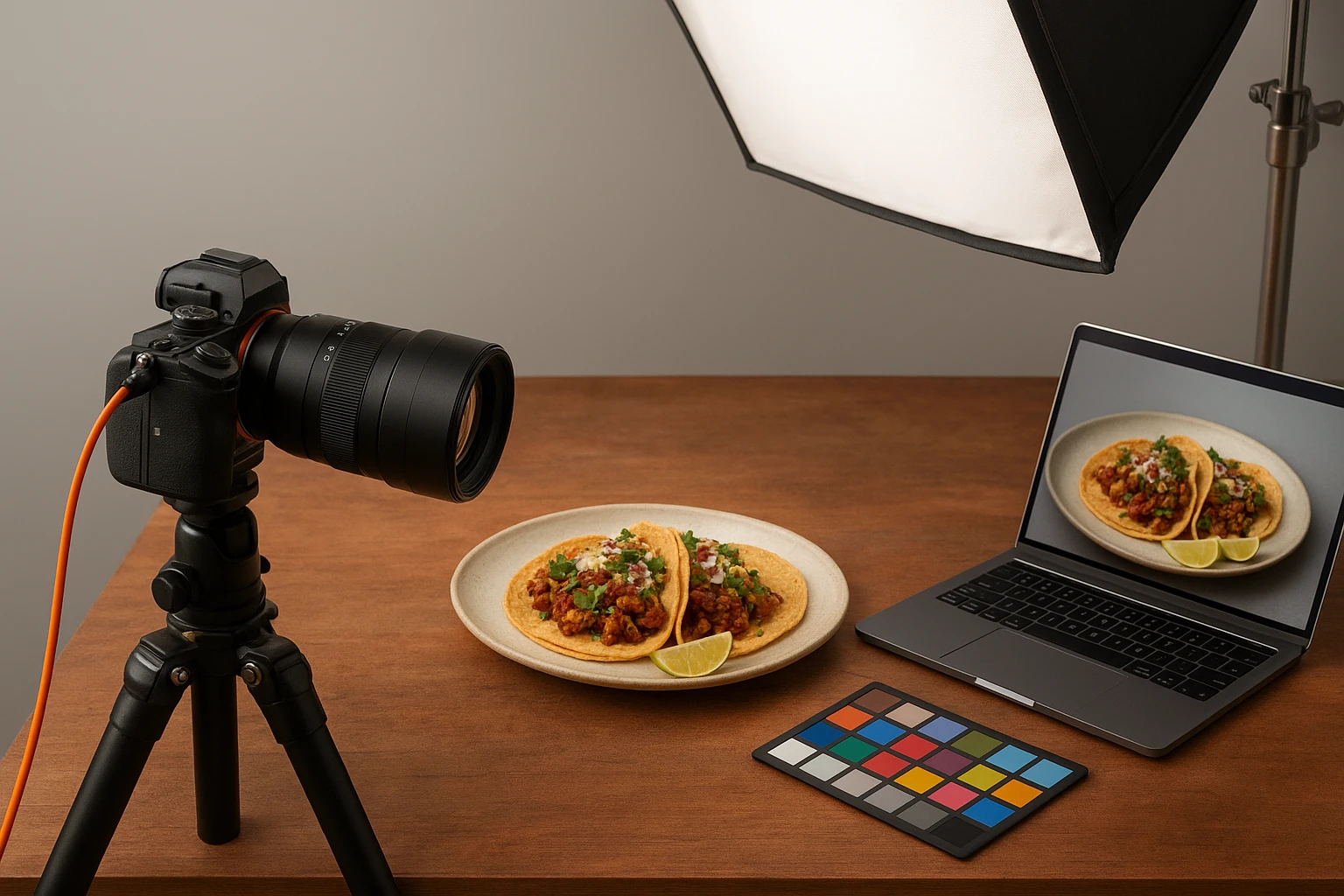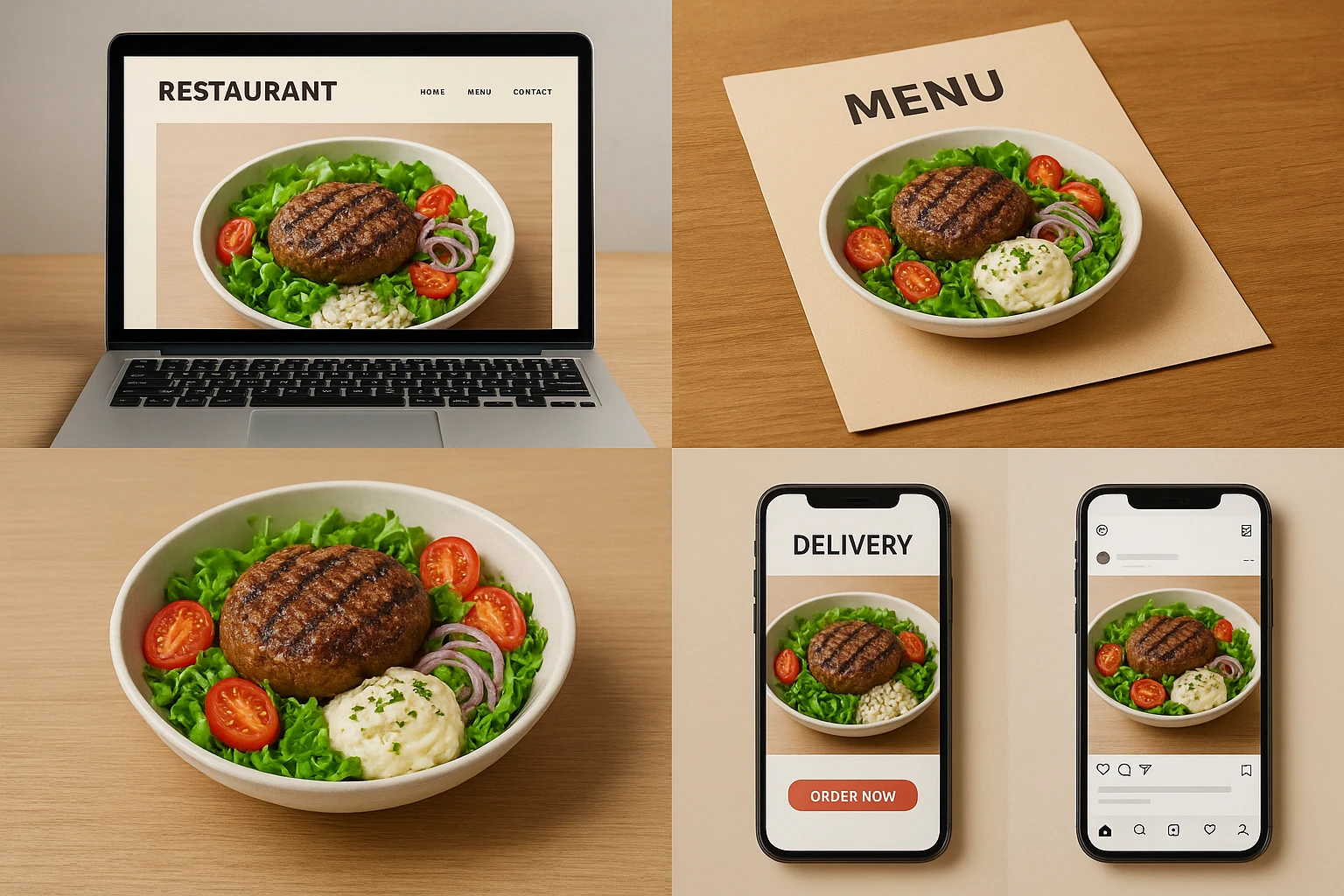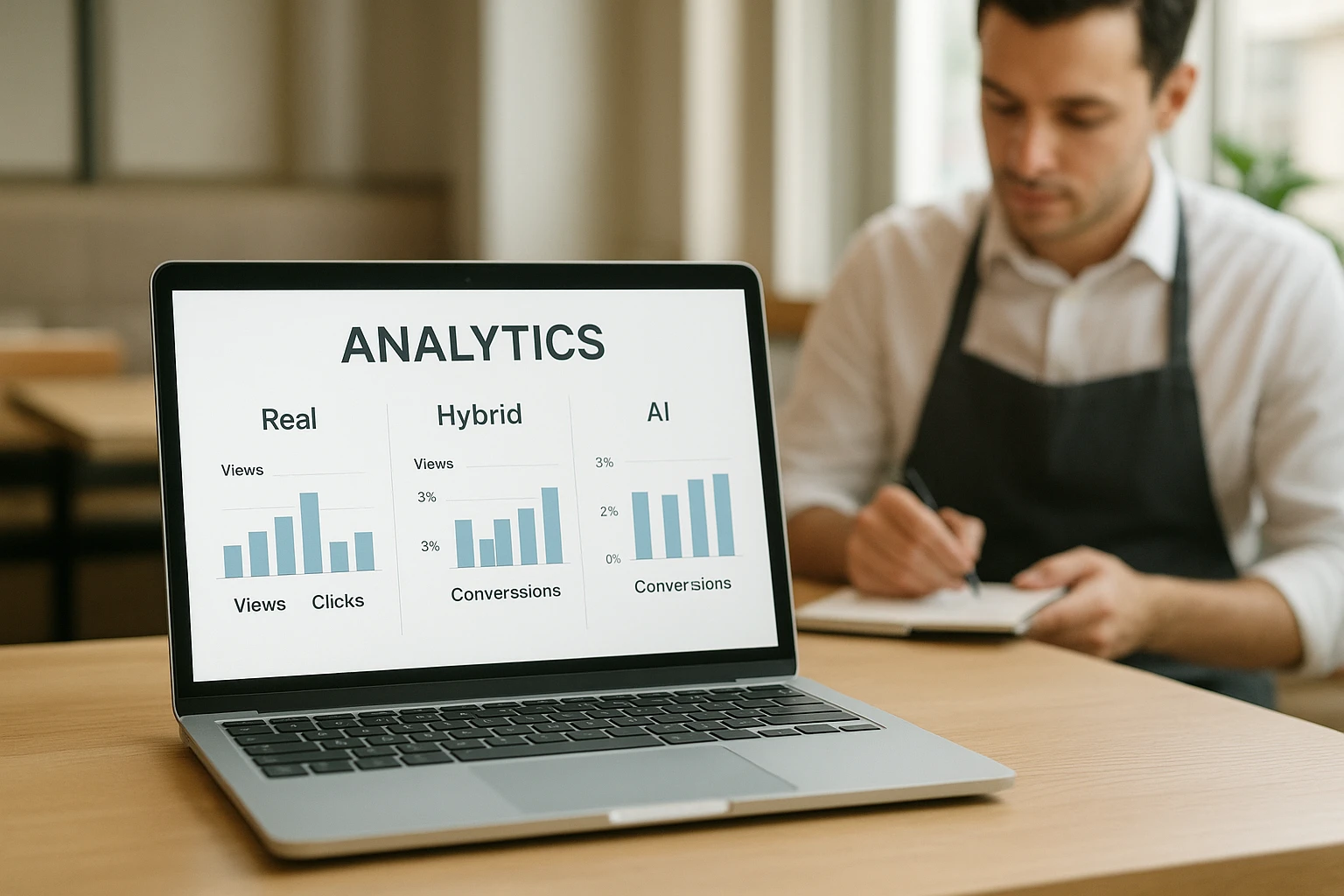Hybrid Food Photography: When to Hire vs Use AI

Quick navigation:
- 1. Why hybrid beats either-or: the operator’s reality check
- 2. The decision framework: when to hire a photographer vs use AI
- 3. Building a hybrid workflow: from brief to asset library
- 4. Channel-by-channel playbook: menus, delivery, social, and beyond
- 5. Testing, metrics, and next-step experiments with Yummify
1. Why hybrid beats either-or: the operator’s reality check
Hybrid Food Photography Decisions at a Glance
| Decision Point | Recommended Path |
|---|---|
| New menu hero images | Hire photographer; use AI for pre-visualization and layout tests |
| Daily social stories & limited-time promos | AI-first with a vetted style; occasional refresh from real shoots |
| Third-party delivery & marketplace imagery | Real photos only; AI assists with background cleanup and consistency |
| Concept testing & R&D items | AI mockups for speed; move to real photography if item launches |
| Evergreen website & brand assets | Hybrid: real food captured once, then AI-extended into variants and formats |
You’re three weeks from a new menu launch. Your content calendar is full of blank spaces: website banners, DoorDash thumbnails, in-store posters, Instagram. Your usual photographer is booked, your budget is already tight, and leadership is pushing you to “use AI so we can move faster.”
If you lean only on AI, you risk photos that look unreal or over-promised-guests order, the plate arrives, and it doesn’t match. If you rely only on traditional shoots, you blow thousands of dollars and still can’t keep up with weekly promos and social trends.
What hybrid food photography really means
Hybrid food photography workflows combine:
- Real photography for assets that must closely match reality.
- AI assistance (like Yummify) for concepting, clean-up, variants, formats, and low-stakes touchpoints.
It’s not “AI vs photographers”. It’s deciding, image by image, which production method fits the risk, impact, and shelf life of that asset.
A simple example:
- Hero burger for your homepage: Shot by a pro once, then run through Yummify to crop vertical for Reels, horizontal for website, and square for delivery apps.
- Daily Instagram stories for that burger: Mostly AI-generated seasonal backgrounds and text overlays, with the core dish still grounded in your real photo.
Why you can’t go AI-only (yet)
Restaurant photos are not abstract art. They set expectations and influence purchase decisions. Uber Eats has reported that listings with high-quality images can significantly increase orders compared with text-only listings, and most marketplaces expect photos that represent real food, not fantasy renders.[^ubereats]
At the same time, consumers are becoming more skeptical of overly-perfect visuals. A 2023 survey from Pew Research Center found that a majority of Americans are aware AI is used in visual media and many worry about being misled. Overpromising with AI food imagery is a fast way to erode trust.
That’s where Yummify fits: as an AI food photography platform, it’s built to style real dishes quickly while still letting you decide where to keep strict realism and where you can safely push creativity.
Pause and list your top 5 upcoming visual needs-menu, web, delivery, social, or in-store-so you can map each to the right hybrid approach as you read on.
[^ubereats]: Example based on marketplace case studies; always check current policies and your own data.

2. The decision framework: when to hire a photographer vs use AI
You don’t need a 40-page policy to decide between photographer, AI, or hybrid. You need a fast triage you can run on every request-“we need photos for the new kids menu” or “marketing wants a TikTok thumbnail by Friday.”
3-question asset triage checklist
Use this checklist before you brief anyone:
- Impact: Will this image meaningfully influence purchase or long-term brand perception?
- Risk: Could an inaccurate or over-stylized version make guests feel misled?
- Shelf life: Will you use this image for months, or is it disposable content for a few days?
Now apply the rules:
- High impact + high risk + long shelf life -> Photographer or hybrid (real base + Yummify variants).
- Medium impact or short shelf life -> Hybrid or AI-first with clear constraints.
- Low impact + low risk + short shelf life -> AI-first.
When a photographer is non-negotiable
Scenarios where you should budget for real photography:
- Signature hero dishes on menus, website, and storefront posters.
- Third-party delivery thumbnails for best-sellers, where inaccurate photos can trigger refunds, bad reviews, or platform scrutiny.
- Packaging and CPG products that need legal accuracy.
Here, Yummify comes in after the shoot: you upload your photographer’s images and use branded environments to standardize lighting, remove distractions, and generate alternate crops without changing the actual food.
Where AI can safely lead
AI-first makes sense when:
- You’re testing a seasonal promotion (e.g., a pumpkin spice latte background for just three weeks).
- You need daily social content: stories, behind-the-scenes style posts, playful alternate backgrounds.
In these cases, you’re not promising a precise plating; you’re reinforcing the vibe. You can even start from a simple phone photo and let Yummify’s prompt enhancement handle the styling details so you don’t spend hours tweaking prompts.
To see how creatives in another field combine real footage and AI, watch this short breakdown from filmmaker Jon Kent. The context is film, but the hybrid thinking maps directly to food visuals:
Borrow the idea: capture reality where it counts, then use AI to storyboard, version, and reformat.
Take one high-impact image you’re planning this month and run it through the triage checklist to choose photographer, AI, or hybrid before you brief anyone.

3. Building a hybrid workflow: from brief to asset library
A framework only works if your team can actually run it. You need a repeatable hybrid workflow that tells everyone-marketing, photographer, franchisees-who does what and when Yummify steps in.
7-step hybrid food photography workflow
-
Define the brief
Clarify goals (e.g., increase online orders for bowls by 10%), channels (Uber Eats, in-store menu, Instagram), and which dishes must be 100% accurate. -
Pre-visualize with AI
Use Yummify to generate moodboards, backgrounds, and angles for your key dishes. A taco chain, for example, might test rustic wood vs. clean white tile vs. street-food metal trays in an afternoon. -
Plan the shoot
Turn AI mockups into a concise shot list: must-have hero dishes, ingredient close-ups, neutral background plates you can later reuse. -
Capture real assets
Your photographer shoots the list in consistent lighting. Even if budget only covers 10 dishes, shoot them in ways Yummify can later repurpose-extra negative space, top-down and 45-degree angles, clean backgrounds. -
AI-extend and version
Upload your selects into Yummify. Apply branded environments to generate localized versions (e.g., different table props for Austin vs. Miami) and new crops for vertical, square, and landscape formats. -
Review and label
In your asset library, clearly label each file as Real, Hybrid (Real + AI), or AI-only and note any constraints. This makes it far easier to keep ethical AI food styling guardrails in place. -
Publish and learn
Deploy across channels, then track basic metrics: click-through, add-to-cart, guest comments. Use that feedback to refine your next shoot list and Yummify prompts.
A quick example
A hypothetical 8-location fast-casual brand runs a single-day shoot for 12 best-sellers. They then:
- Use Yummify to generate 4-5 variants per dish for social and email.
- Reserve the untouched real photos for menus and delivery.
Result: dozens of assets from one shoot instead of booking another photographer for every seasonal promo.
Sketch your own 5-7 step hybrid workflow and note where Yummify, your photographer, and your team each plug in so responsibilities are crystal clear.

4. Channel-by-channel playbook: menus, delivery, social, and beyond
Different channels carry different expectations. A guest might forgive an artsy Instagram post, but they will not forgive a delivery photo that looks nothing like what shows up at their door.
Hybrid content mix by channel
| Channel | Core goal | Real vs AI mix | AI allowed to… | AI never should… |
|---|---|---|---|---|
| Website menu & ordering | Trust + conversion | Real-heavy / hybrid assist | Standardize lighting, remove distractions, reformat for mobile/desktop. | Change portion size, add ingredients that don’t exist, or alter core plating. |
| In-store printed menus | Expectation setting | Real-only or light hybrid | Sharpen, correct color, clean up minor spills. | Make food look dramatically larger or impossible to recreate. |
| Third-party delivery apps | Accuracy + reviews | Real-only with light AI cleanup | Normalize backgrounds and crops. | Invent textures, drips, or impossible steam. |
| Organic social & stories | Conversation + freshness | Hybrid / AI-first | Swap backgrounds, test seasonal themes, create playful sequences. | Depict imaginary menu items without clear labeling. |
| Franchise/local promos | Localization + speed | Hybrid | Change props, table settings, copy overlays. | Alter the product so it no longer matches spec. |
Real examples
- Website and in-store menus: Use your photographer’s shots as the base. Run them through Yummify for consistent color and aspect ratios so your restaurant menu imagery feels cohesive without reshooting everything.
- Delivery apps: Treat these like contracts with guests. Platforms like DoorDash and Uber Eats expect images to represent actual dishes; misrepresentation can lead to bad reviews or de-prioritized listings. Check each marketplace’s current guidelines before experimenting.
Social is your playground:
- Turn a single real salad shot into a week of posts by changing seasons (bright summer, cozy fall) using Yummify’s branded environments.
- Test motion-style sequences by generating variations with slight plating changes-still honest, still recognizably your dish.
Pick one channel-delivery apps or social-and write down two AI tasks you’ll allow and two you’ll explicitly forbid so your team has guardrails.

5. Testing, metrics, and next-step experiments with Yummify
Before you rewrite your brand guidelines, prove the hybrid approach on a small, low-risk pilot. That way, you can walk into the next leadership meeting with numbers, not opinions.
Simple hybrid pilot plan
Choose one of these as a starting point:
- A single menu section (e.g., bowls or desserts) for your online ordering site.
- A limited-time offer (LTO) running for 4-6 weeks.
For that pilot, plan:
- 1 short real shoot for key dishes.
- Yummify-powered AI variants for social, email, and maybe secondary website images.
Tag every asset in your library as Real, Hybrid, or AI-only. Then track, at minimum:
- Click-through rate to item detail pages.
- Add-to-cart or order rate.
- Guest comments, complaints, and refunds.
- Time from recipe sign-off to visuals going live.
As analytics tools, restaurant platforms like Toast emphasize watching contribution margin and item mix; you’re doing the same with imagery, just focusing on conversion and trust instead of cost of goods.
Turning learnings into rules
After 4-6 weeks:
- Compare performance of Real vs Hybrid vs AI-only images.
- Ask operators and guests where photos felt “off” or confusing.
- Update your brand guide with 1-2 clear rules per channel and a short do/don’t list for AI.
Yummify helps here because your prompts, branded environments, and asset labels live in one place-so once you know what works, you can roll that playbook out to franchisees and local managers without handing them a blank canvas.
Define one metric you care about most-conversion, speed-to-launch, or guest trust-and design your first hybrid test around moving that single number.

Next steps
If you’re staring at an upcoming menu change or promo calendar and wondering how you’ll produce enough honest, high-performing visuals in time, start with a small hybrid test. Book a short shoot for your must-have hero dishes, then load those images into Yummify to generate on-brand variants for web, delivery, and social in a single afternoon. Once you see which mix of Real, Hybrid, and AI-only images performs best, codify those rules into your playbook-and use Yummify’s branded environments and asset labels to keep every location on the same page.
FAQ
Can I legally use AI-generated images to promote menu items that don’t exist yet?
You can usually use AI mockups internally for R&D, menu planning, or investor decks without much risk, because guests never see them. Public promotion is different: advertising a dish as currently available when it is not can run afoul of truth-in-advertising rules in many regions, and delivery marketplaces may treat it as misrepresentation. A safer pattern is to label clearly that you are previewing a concept (“coming soon” or “prototype imagery”) and switch to real photography as soon as the item is finalized. Always have local legal counsel review any campaign that uses AI to depict future items as if they are already on the menu. When in doubt, use AI only for internal testing and concept boards until the dish is real.
How do I disclose AI use in food photography without scaring guests or hurting conversion?
Most guests don’t need a disclaimer on every Instagram post, but transparency matters for high-stakes surfaces like menus and ordering sites. A practical option is a short note in your digital footer or FAQ explaining that you use a mix of real and AI-assisted images, and that all visuals are designed to reflect real dishes as accurately as possible. For clearly stylized social content, adding a light-touch tag in the caption (“styled with AI” or “concept image”) can actually build trust by showing you’re not hiding the ball. If you adopt formal AI policies in your brand guidelines, make sure franchisees understand when and how to use these disclosures consistently.
What are clear red lines where AI should never replace real food photography?
There are a few reliable red lines. First, anything that functions as a “promise” of a specific plate-menu panels, delivery thumbnails for best sellers, and packaging-should be grounded in real photography, with only subtle AI cleanup if used at all. Second, any image that must match legal product specs (like an ingredient callout on packaging) should be photographed as-is. Third, avoid using AI to materially change portion sizes, add ingredients you don’t serve, or depict textures your kitchen can’t achieve; this is where guests feel most misled and where complaints spike. Use AI aggressively for concepting and social storytelling, not for rewriting the truth of the dish itself.
How do I keep franchisees or local managers from overusing AI and over-stylizing dishes?
The best defense is a clear, simple playbook combined with constrained tools. In your brand guidelines, spell out 3-5 non-negotiable rules: which channels must use approved real photos, what AI is allowed to change (backgrounds, props, crop) and what it can never change (portion size, ingredients, saucing). Inside Yummify, create a small set of branded environments and require franchisees to use only those styles so you don’t get wild deviations. You can also ask locations to submit top-performing AI-assisted images for central review each month, both to catch problems and to add the best local content into your master library. Training sessions that show “good” vs “bad” uses of AI food styling help make the rules tangible.
What budget impact should I expect when moving to a hybrid workflow?
Expect your per-dish cost for core hero photography to stay similar, but your cost per usable asset should drop substantially. Instead of paying a photographer to reshoot every seasonal background or social variant, you can capture a strong base image once and use Yummify to generate many derivatives. That typically lets brands reduce full-scale shoots from, say, quarterly to twice a year, while still increasing total asset volume. You also cut rush fees and downtime; when marketing needs a new banner tomorrow, AI variants from existing shots are far cheaper than a last-minute shoot. The exact savings will vary, so track how many final assets you get per shoot before and after adopting hybrid workflows.
How can I measure whether AI-assisted images are actually improving performance?
Treat AI vs real images like any other A/B test. On your website or app, show half your audience a traditional photo and half a Yummify-assisted variant, then compare click-through to item pages and add-to-cart rates over a few weeks. On delivery apps, rotate thumbnails for one or two items over time and watch how order volume and review sentiment shift. In parallel, have staff track guest comments and refund or remake requests tied to photos not matching reality. If AI-assisted images lift clicks without increasing complaints or refunds, you’ve found a productive hybrid zone; if complaints rise, tighten your guardrails and rely more heavily on real photography for that channel.


